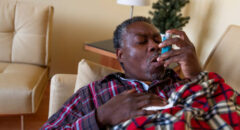
Living with Chronic Obstructive Pulmonary Disease (COPD) can be challenging, but there are resources and programs available to help you manage your condition and improve your quality of life. One such resource is Pulmonary Rehabilitation, a comprehensive program designed to support individuals with COPD. If you're considering pulmonary rehab or just want to learn more, you've come to the right place! In this article, we'll answer the top 10 questions about pulmonary rehab for COPD.
1. What is Pulmonary Rehabilitation?
Pulmonary Rehabilitation is a structured program that combines exercise, education, and support to help individuals with COPD breathe easier, improve their physical fitness, and enhance their overall well-being.
According to Health Central, you can expect to learn the following at pulmonary rehab:
- How to use your COPD medications
- How to avoid lung infections from COPD
- How to use oxygen therapy for COPD (if you require it)
- Nutritional counseling for COPD, since healthy eating supports your ability to exercise and your overall health.
2. Who is Eligible for Pulmonary Rehab?
Pulmonary rehab is typically recommended for people with COPD, but eligibility may also extend to those with other chronic lung conditions. You may be referred by your doctor, or you can inquire about it yourself.
“In general, if a patient has shortness of breath while walking on a flat surface, they would qualify,” James Woodrow, M.D., a pulmonologist at National Jewish Health in Denver, Colorado tells Health Central.
You can attend pulmonary rehab at your local hospital or outpatient health center.
RELATED: Managing COPD: Tips for Improving Quality of Life
3. What are the Benefits of Pulmonary Rehab?
Pulmonary rehab offers several advantages, including improved lung function, increased exercise tolerance, reduced breathlessness, enhanced quality of life, and better disease management skills.
Pulmonary rehab can also help you learn how to eat well and offer smoking cessation counseling if you are a smoker. “Programs offer general education on recommended diets and dietary modifications, recommended levels of cholesterol and blood glucose, and how to read food labels,” Eric Lang, M.D., a pulmonologist at the University of Miami Health System in Florida tells Health Central.
4. How Long Does Pulmonary Rehab Last?
The duration of pulmonary rehab programs can vary, but they typically last for several weeks to a few months. The frequency of sessions can range from a few times a week to once a week, depending on the program.
After the program, you should be able to breathe easier and lead a comfortable and independent life.
5. What Happens During a Pulmonary Rehab Session?
A typical session includes a combination of supervised exercise, education on COPD management, and emotional support. You'll work with a physical therapist (PT), the program’s medical director and a pulmonologist to create a customized plan that suits your needs.
These professionals will conduct an evaluation of how much exercise you can do, including a COPD six-minute walk test. During the test, you’ll be asked to walk on a flat surface, such as a hospital corridor, while hooked up to a pulse oximeter (a device that tracks your heart rate and the oxygen level in your blood), according to Health Central.
After walking back and forth for about 100 feet, the test will determine how far you can walk at your normal pace in six minutes. The test will be repeated throughout the program to measure your progress and you will be provided supplemental oxygen as you need it and the ability to stop or slow down anytime throughout the test.
You will also undergo tests of balance, lower body strength, and breathing to help professionals determine how strong your breathing muscles are and create a workout plan tailored to your needs.
6. Is Pulmonary Rehab Covered by Insurance?
Many health insurance plans cover pulmonary rehab, but it's essential to check with your provider to determine your specific coverage and any associated costs.
Private companies may make their own rules, while others may follow Medicare guidelines. Medicare covers up to 36 sessions over a period of up to 36 weeks. You may qualify for an additional 36 sessions if you develop COVID-19 after you complete your program, Dr. Lang notes.
RELATED: Can COPD Be Reversed?
7. Can I Exercise During Pulmonary Rehab If I'm Out of Shape?
Absolutely! Pulmonary rehab programs are tailored to your fitness level, and healthcare professionals will gradually increase the intensity of exercises as you progress. It's a safe and effective way to improve your physical condition.
8. What If I Can't Attend In-Person Sessions?
If attending in-person sessions is challenging due to distance or other factors, some pulmonary rehab programs offer remote or virtual options. Discuss this with your healthcare provider to find a suitable solution.
9. Can I Continue Exercising After Pulmonary Rehab?
Yes! Pulmonary rehab aims to instill a healthy lifestyle that includes regular exercise. You'll learn exercises and techniques that you can continue at home or at a local gym to maintain your progress.
“A major goal is that as the program progresses, patients are motivated and educated to continue independent exercise that they can replicate on their own,” says Dr. Lang
10. How Do I Get Started with Pulmonary Rehab?
To begin pulmonary rehab, speak with your primary care physician or pulmonologist. They can refer you to a program that suits your needs. It's essential to take this step, as pulmonary rehab can significantly improve your COPD management and overall well-being.
Conclusion
Pulmonary rehabilitation is a valuable resource for individuals living with COPD. It offers a holistic approach to managing the condition and can greatly enhance your quality of life. If you have COPD or know someone who does, consider exploring pulmonary rehab as a supportive and effective tool in the battle against this chronic lung disease. It's never too late to take control of your health and breathe easier.









